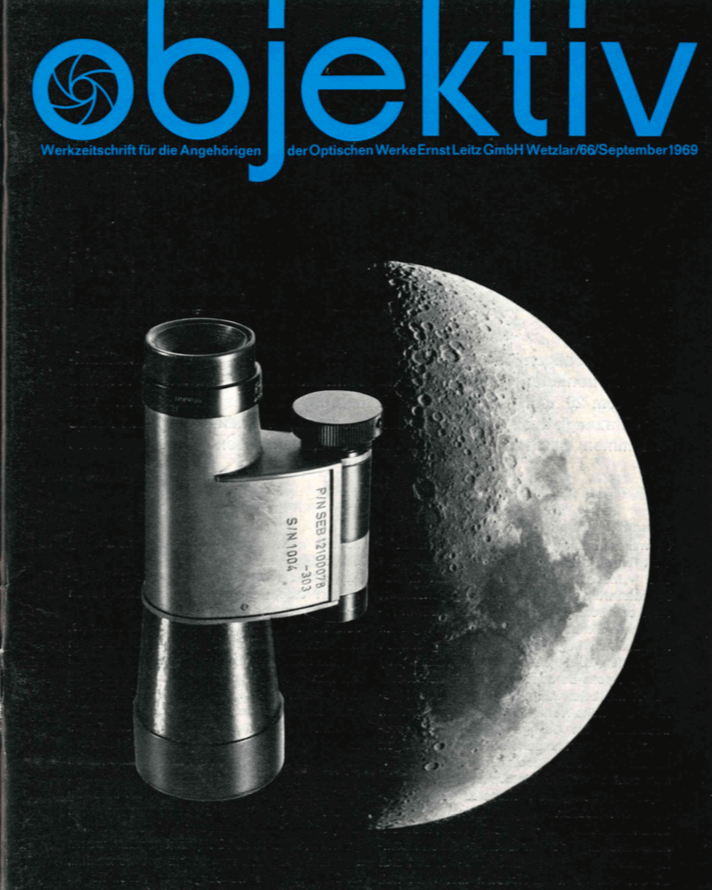
The Apollo 11 moon landing
50 years ago wasn’t just a giant leap for mankind – it was also a historical
event for the Ernst Leitz optical factory in Wetzlar, Germany. NASA, based in
Houston (Texas), had ordered a special Leitz Trinovid from Ernst Leitz GmbH for
the lunar mission in July 1969. The original Leitz Trinovid manufactured for
the Apollo 11 mission can be found in the Leica Camera AG archive.

Neil Armstrong, Buzz
Aldrin, and Michael Collins landed on the moon 50 years ago: on July 20, 1969.
The Leitz Trinovid specially developed for the Apollo missions is a monocular,
consisting of one tube focused over the central bar. Mainly for weight reasons,
the NASA scientists had decided on a customized version – the special monocular
known to this day as the “Eye of Apollo”. In addition to the monocular, NASA
also used other products from the Ernst Leitz company: Leitz microscopes were
employed in their laboratories to examine the moon’s rocks, and the launches of
Saturn V rockets with Apollo spacecraft were documented using Leica and
Leicaflex cameras.



“Our monocular TRINOVID 10
x 40 already flew with the Apollo 8 and Apollo 10 missions and was an important
navigation aid for the crew of Apollo 11 and the lunar module ‘Eagle’.
According to NASA research, it proved to be the best of our many glasses
offered for this mission,” noted Jerry Rzeznik, a Leitz employee at the time,
in the September 1969 issue of the Leitz employee magazine Objektiv. Jerry
Rzeznik also provided detailed information on where the Leitz Trinovid
monocular was used: “We all know that the moon can only be reached with
multi-stage rockets. There are separations of the individual stages,
disconnections and couplings of spacecraft. These difficult maneuvers require
precise preparation and timely detection of the arriving and departing parts.
(…) At the speeds the spacecraft were traveling at, it was necessary to locate
them from a distance of about 300 km.”

telegram
to our friends
astronauts used binocular
trinovid 10 x 10
in Apollo 11 + was
already on board of
Apollo 8 and 10 + trinovid
obviously selected
by nasa because with
optimum performance
small light handy and atmospherically
independent +
are proud of this proof of
quality +
7. 21, 1969 ernst leitz gmbh wetzlar
In a telegram dated July
21, 1969, the company writes: “astronauts use monocular trinovid 10 x 40 in
apollo 11 + was already on board apollo 8 and 10 + trinovid obviously chosen by
NASA for highest performance plus small lightweight handy and atmospherically
independent + are proud of this proof of quality.”
Photos: NASA Archive/Leica
Camera Archive
For more information on other Leica products and cameras used by NASA go here.
_____________________________________________________________________
_____________________________________________________________________
 Buy vintage Leica cameras from
America's premier Leica specialist
Buy vintage Leica cameras from
America's premier Leica specialist
http://www.tamarkinauctions.com/ http://www.tamarkin.com/leicagallery/upcoming-show

Buy vintage Leica cameras from
America's premier Leica specialist
http://www.tamarkinauctions.com/ http://www.tamarkin.com/leicagallery/upcoming-show
Click on image to enlarge
Order: info@gmpphoto.com
Please make payment via PayPal to GMP Photography
Click on image to enlarge
Order: info@gmpphoto.com
Click on image to enlarge
Order: info@gmpphoto.com
Click on image to enlarge
Order: info@gmpphoto.com
Please make payment via PayPal to GMP Photography
Click on image to enlarge
Order: info@gmpphoto.com
Please make payment via PayPal to GMP Photography
Click on image to enlarge
Order: info@gmpphoto.com
Please make payment via PayPal to GMP Photography












No comments:
Post a Comment